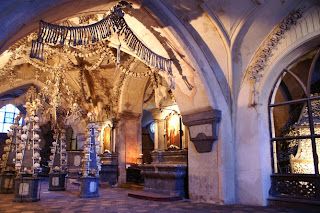Introduction
There are a number of places in the world that display the dead in one way or another for the edification of any visitor with a strong stomach. My presentation is about three chapels, which are located in three different countries – Portugal, Italy and Czech.
Capela dos Ossos
The Capela dos Ossos or in English Chapel of Bones is one of the best-known monuments in Évora, Portugal. It is a small interior chapel located next to the entrance of the Church of St. Francis.
The Church of St. Francis itself was built in the Gothic style between 1460 and 1510. Its Capela dos Ossos was created by a few Franciscan monks in the 16th century as a practical solution to a problem - as many as 42 monastic cemeteries were taking up valuable space in Evora, so they moved all the bones to a single consecrated chapel. The monks wanted to show the inevitability of death.
This is clearly shown in the famous warning at the entrance Nós ossos que aqui estamos pelos vossos esperamos (“We bones, lying here bare, are awaiting your's).
The lugubrious chapel walls and eight pillars are "decorated" in carefully arranged bones and skulls held together by cement. The number of skeletons of monks was calculated to be about 5000.
Two desiccated corpses, one of which is a child, dangle from a chain. Their identities are unknown, but there are plenty of legends: one popular story says they are an adulterous man and his infant son, cursed by his jealous wife.
Capuchin Crypt
The Capuchin Crypt is a small space comprising several tiny chapels located beneath the church of Santa Maria della Concezione dei Cappuccini in Rome, Italy that was built in 1626. The Capuchin Crypt contains the skeletal remains of 4,000 bodies believed to be Capuchin friars buried by their order. The Catholic order insists that the display is not meant to be macabre, but a silent reminder of the swift passage of life on Earth.
Large numbers of the bones are nailed to the walls in intricate patterns, many are piled high among countless others, while others hang from the ceiling as light fixtures.
When the monks arrived at the church in 1631, they brought 300 cartloads of deceased friars. The soil in the crypt was brought from Jerusalem.
As monks died during the lifetime of the crypt, the longest-buried monk was exhumed to make room for the newly deceased that was buried without a coffin, and the newly reclaimed bones were added to the decorative motifs. Bodies typically spent 30 years decomposing in the soil, before being exhumed.
There are six total rooms in the crypt, five featuring a unique display of human bones believed to have been taken from the bodies of friars who had died between 1528 and 1870.
- Crypt of the Resurrection, featuring a picture of Jesus raising Lazarus from the dead, framed by various parts of the human skeleton
- The Mass Chapel, as an area used to celebrate Mass, does not contain bones
- Crypt of the Skulls
- Crypt of the Pelvises
- Crypt of the Leg Bones and Thigh Bones
- Crypt of the Three Skeletons The center skeleton is enclosed in an oval, the symbol of life coming to birth
Sedlec Ossuary
The Sedlec Ossuary is a small Roman Catholic chapel, located beneath the Cemetery Church of All Saints in Sedlec, a suburb of Kutná Hora in the Czech Republic. The ossuary is estimated to contain the skeletons of between 40,000 and 70,000 people, many of whom have had their bones artistically arranged to form decorations and furnishings for the chapel.
A cistercian monastery was founded near here in the year 1142. One of the principal tasks of the monks was the cultivation of the grounds and lands around the monastery. In 1278 King Otakar II of Bohemia sent Henry, the abbot of Sedlec, on a diplomatic mission to the Holy Land. When leaving Jerusalem Henry took with him a handful of earth from Golgotha, which he sprinkled over the cemetery of Sedlec monastery, consequently the cemetery became famous, not only in Bohemia but also throughout Central Europe. Many wealthy people desired to be buried here. The burial ground was enlarged during the epidemics of plague in the 14th century and also during the Hussite wars in first quarter of the 15th century.
After 1400 one of the abbots had a church of All -Saints erected in Gothic style in the middle of the cemetery and under it a chapel destined for the deposition of bones from abolished graves, a task which was begun by a half blind Cistercian monk after the year 1511. The present arrangement of the bones dates from 1870 and is the work of a Czech wood-carver, František RINT.
The most interesting creations by Master Rint are the chandelier in the centre of the nave, containing all the bones of the human body, two monstrance’s beside the main altar and the coat-of arms of the Schwarzenberg noble family on the left-hand side of the chapel.






















